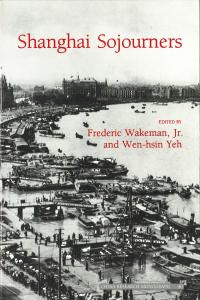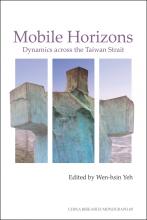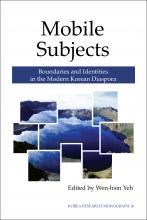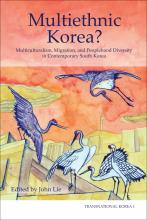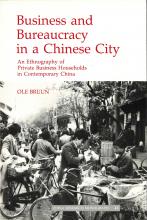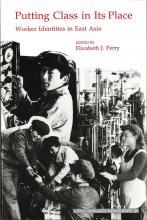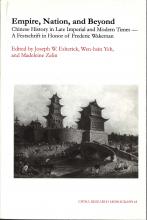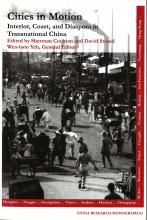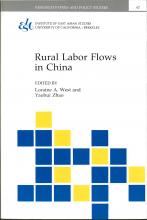Shanghai Sojourners
Shanghai Sojourners
Frederic Wakeman Jr., ed., Wen-hsin Yeh, ed.
This volume describes Shanghai's sojourners and how they formed their identities in the leading metropolis of the lower Yangzi valley. The city's sojourners included foreigners, but were mostly Chinese immigrants from the countryside. They came in waves, attracted to the light industry and commerce, as well as the new form of cosmopolitanism, that were developing in the city.
As a nonprofit academic press, we need your support to publish our books. Your gift can help us make more of our titles available as e-books. DONATE NOW
Title information
Shanghai's population increased tenfold between 1842 and 1945. The city's sojourners included foreigners, but were mostly Chinese immigrants from the countryside. They came in waves, attracted to the light industry and commerce, as well as the new form of cosmopolitanism, that were developing in the city. This volume describes the sojourners and how they formed their identities in the leading metropolis of the lower Yangzi valley.
Contributors:
Marie-Claire Bergère is Professor of Chinese Civilization at the Institut National des Langues et Civilisations Orientales of the Institut de la Sorbonne Nouvelle.
Sherman Cochran is Professor and Chair of History at Cornell University.
Bryna Goodman is Associate Professor of History at the University of Oregon.
Gail Hershatter is Professor of History at the University of California, Santa Cruz.
Emily Honig is Associate Professor of Women's Studies at Yale University.
Brian G. Martin is a foreign policy specialist in the Australian Parliamentary Research Service.
Elizabeth J. Perry is Professor of Political Science at the University of California, Berkeley.
Frederic Wakeman, Jr., is Walter and Elise Haas Professor of Asian Studies and Director of the Institute of East Asian Studies at the University of California, Berkeley.
Jeffrey Wasserstrom is Associate Professor of History at the University of Indiana.
Wen-hsin Yeh is Assistant Professor of History and Vice-chair of the Center for Chinese Studies at the University of California, Berkeley.
Frederic Wakeman Jr., ed.
Frederic Wakeman Jr. (1937–2006) was Walter and Elise Haas Professor of Asian Studies and director of the Institute of East Asian Studies at the University of California, Berkeley.
B.A. Harvard University, Ph.D. University of California, Berkeley
Wen-hsin Yeh, ed.
Wen-hsin Yeh is professor of history at the University of California, Berkeley. She has served as the director of the Institute of East Asian Studies and the chair of the Center for Chinese Studies at Berkeley. She has edited and contributed to many IEAS publications, including Mobile Subjects; Mobile Horizons; History in Images; Cities in Motion; Empire, Nation, and Beyond; Cross-Cultural Readings of Chineseness; Landscape, Culture, and Space in Chinese Society; and Shanghai Sojourners.
B.A., History, National Taiwan University; M.A., History, University of Southern California; Ph.D., History, University of California, Berkeley
Shanghai Sojourners
Acknowledgments – vii
Contributors – ix
Map – xi
Introduction – 1
Frederic Wakeman, Jr., and Wen-hsin Yeh
1. The Shanghai Bankers' Association, 1915–1927: Modernization and the Institutionalization of Local Solidarities – 15
Marie-Claire Bergère
2. Three Roads into Shanghai's Market: Japanese, Western, and Chinese Companies in the Match Trade, 1895‑1937 – 35
Sherman Cochran
3. New Culture, Old Habits: Native-Place Organization and the May Fourth Movement – 76
Bryna Goodman
4. The Evolution of the Shanghai Student Protest Repertoire; or, Where Do Correct Tactics Come From? – 108
Jeffrey Wasserstrom
5. Regulating Sex in Shanghai: The Reform of Prostitution in 1920 and 1951 – 145
Gail Hershatter
6. Progressive Journalism and Shanghai's Petty Urbanites: Zou Taofen and the Shenghuo Weekly, 1926–1945 – 186
Wen-hsin Yeh
7. Migrant Culture in Shanghai: In Search of a Subei Identity – 239
Emily Honig
8. "The Pact with the Devil": The Relationship between the Green Gang and the French Concession Authorities, 1925–1935 – 266
Brian G. Martin
9. Strikes among Shanghai Silk Weavers, 1927–1937: The Awakening of a Labor Aristocracy – 305
Elizabeth J. Perry
Index – 343
|
JOURNAL REVIEWS |
|
"This is the best academic collection yet published on early twentieth-century Shanghai....[The contributors] provide plenty of evidence for the power of concrete changes which are not obviously rooted in anybody's identity. This makes for history writing that sometimes seems shaped by an academic fad. But it also makes for a rare work: an edited collection that really holds together as a book." ~Lynn T. White III, Princeton University, in The Australian Journal of Chinese Affairs (http://www.jstor.org/stable/2949940) |
|
"Shanghai Sojourners is an extraordinary anthology of articles on Shanghai society. The term 'sojourners' has been used to capture the nature of the metropolis’ residents from the granting of the foreign concessions to the early 1950s: transient, constantly changing, lacking roots, and |
|
"This book is about the culture and society of a city of strangers, the Shanghai of the Republican era....It is primarily that of Chinese bankers, industrialists, workers, students, journalists, gangsters and prostitutes who only gradually came to think of themselves as 'Shanghai people.' Theirs was a Shanghai that, as the editors describe it, had an 'exotic, disturbing, polymorphous quality' that ended when a cosmopolitan Shanghai became 'securely Chinese' in 1949 (p. 14)." ~William C. Kirby, in The China Quarterly (http://www.jstor.org/stable/655153) |
|
"This symposium volume of nine articles, the product of a 1988 conference in Shanghai, has both an evocative and provocative title. Not only does the phrase 'Shanghai sojourners' help conjure up the exotic and complex image of the city from its opening to foreign trade in 1843 through the Communist takeover just over 100 years later, but it also raises a number of intriguing questions about what it meant to live in Shanghai and how that differed from living in other parts of China....Using a rich variety of research methods and many newly-opened archival sources in Shanghai, the authors focus on the period from the late nineteenth century to the 1940s, but with special emphasis on the 1920s and 30s." ~Pamela Atwell, in Journal of the Royal Asiatic Society (http://www.jstor.org/stable/25182923) |

